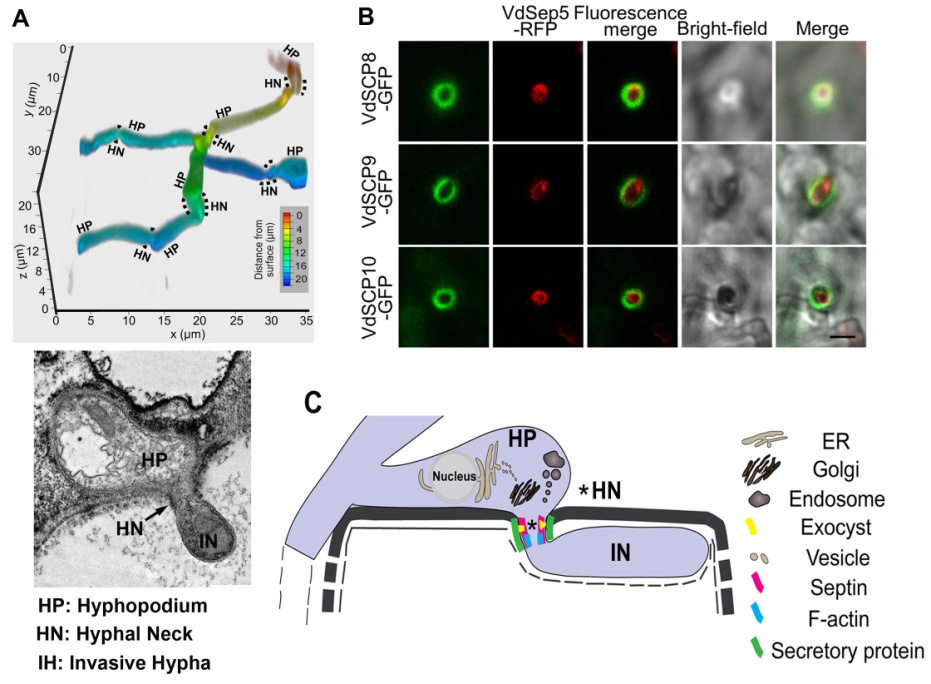Verticillium dahliae (V. dahliae) is a soil-borne, root-infecting fungal pathogen that causes severely wilt disease and leads to serious economic loss worldwide. As most of phytopathogens, V. dahliae would secrete effector proteins to evade or suppress plant immunity for successful infection of the host plants. However, the mechanism(s) by which root-infecting fungal pathogens secrete secretory effector proteins remains unexplored.
Dr. GUO Huishan’s group in the State Key Laboratory of Plant Genomics, Institute of Microbiology of Chinese Academy of Sciences, provides for the first time the mechanism of the delivery of secretory proteins by V. dahliae during plant root infection.
They previously found that V. dahliae develops an infectious structure, hyphopodium, which develops a penetration peg to pierce plant roots. In this study, they observed that after penetration, the penetration peg-developed hyphal neck came into close contact with the host, forming the fungus-host penetration interface.
They observed repeated development of the hyphopodium and hyphal neck for each root cell wall penetration during V. dahliae infection (Figure A). The cytoskeleton protein septin (VdSep5) and F-actin were organized as ring structures at the hyphal neck.
Using GFP tagging and live cell imaging, they observed that several signal peptide containing secreted proteins showed ring signal accumulation/secretion at the penetration interface surrounding the septin ring. They revealed that VdSep5 plays a role in efficient secretion of secretory proteins.
Moreover, they provided evidences that the vesicular trafficking factors VdSec22 and VdSyn8 and the exocyst subunit VdExo70 are also involved in the secretion. Together with the loss/reduced of virulence when VdSep5, VdSec22, VdSyn8 or VdExo70 was deleted, their data demonstrate that the V. dahliae infection structure functions as a key signaling hub during plant infection and is the apparatus that not only breaches host cells but also provides a unique interface for the secretion of fungal effectors.
The paper entitled “Secretory proteins are delivered to the septin organized penetration interface during root infection by Verticillium dahliae” has been published online in PLoS Pathogens (http://journals.plos.org/plospathogens/article?id=10.1371/journal.ppat.1006275) with the Dr. ZHOU Ting-Ting as the first author and Dr. GUO as corresponding author.
This work was supported by grants from the Strategic Priority Research Program of the Chinese Academy of Sciences and the China Transgenic Research and Commercialization Key Special Project.
 ;(C). Simple schematic of secretory protein preferential delivery to the hyphal neck in V. dahliae. (Image by Dr. GUO’s group)
;(C). Simple schematic of secretory protein preferential delivery to the hyphal neck in V. dahliae. (Image by Dr. GUO’s group)
Figure (A). Confocal laser scanning microscopy image of repeated development of hyphopodium (HP) and hyphal neck (HN) of V. dahliae on plant roots (upper panel), and transmission electron microscopy image of hyphopodium (HP), hyphal neck (HN) and invasive hypha (IH) (lower panel). (B). VdSCPs-GFP ring localized outside of the VdSep5-RFP ring. Bar = 2.5 μm
Contact
Prof. GUO Huishan
Institute of Microbiology, Chinese Academy of Sciences
E-mail: guohs@im.ac.cn